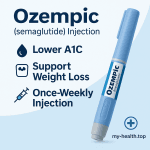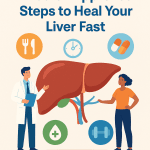This article is for informational purposes only and is not a substitute for professional medical advice. Always consult your healthcare provider for personalized recommendations.
Understanding Heart Disease
Heart disease remains a leading cause of death worldwide, affecting millions of people each year. The term encompasses various conditions, including coronary artery disease, heart attacks, and heart failure. But what if you could take steps to reduce your risk?
Why Prevention Matters
Preventive measures can significantly decrease the likelihood of developing heart disease. According to the Centers for Disease Control and Prevention (CDC), heart disease is responsible for about 697,000 deaths in the United States annually. This staggering statistic underscores the importance of understanding and implementing preventive strategies.
Recognizing Risk Factors
Before diving into preventive measures, it’s essential to recognize the risk factors associated with heart disease. These can be categorized into two groups: modifiable and non-modifiable.
Non-Modifiable Risk Factors
- Age: The risk increases with age, particularly for men over 45 and women over 55.
- Family History: A family history of heart disease can elevate your risk.
- Gender: Men are generally at higher risk than women until women reach menopause.
Modifiable Risk Factors
- High Blood Pressure: This silent killer can lead to serious complications.
- High Cholesterol: Elevated LDL (bad cholesterol) levels can clog arteries.
- Smoking: Tobacco use is a significant risk factor for heart disease.
- Physical Inactivity: A sedentary lifestyle contributes to obesity and heart issues.
- Unhealthy Diet: Poor nutrition can lead to weight gain and other health problems.
- Diabetes: This condition can damage blood vessels and increase heart disease risk.
Implementing Lifestyle Changes
Making lifestyle changes can have a profound impact on your heart health. Here are some actionable steps you can take:
1. Adopt a Heart-Healthy Diet
Nutrition plays a pivotal role in heart health. A heart-healthy diet includes:
- Fruits and Vegetables: Aim for a variety of colors and types to ensure you get a range of nutrients. For example, leafy greens like spinach and kale are rich in vitamins and antioxidants.
- Whole Grains: Foods like brown rice, quinoa, and whole-grain bread can help lower cholesterol levels and provide fiber.
- Lean Proteins: Opt for fish, poultry, beans, and nuts instead of red meats. Fatty fish like salmon are particularly beneficial due to their omega-3 fatty acids.
- Healthy Fats: Incorporate sources of unsaturated fats, such as olive oil and avocados, while limiting saturated and trans fats. A good rule of thumb is to read labels and avoid anything with hydrogenated oils.
2. Engage in Regular Physical Activity
Exercise is crucial for maintaining a healthy heart. The World Health Organization (WHO) recommends at least 150 minutes of moderate-intensity aerobic activity each week. This can include:
- Walking: A simple yet effective way to get moving. Consider taking the stairs instead of the elevator.
- Swimming: A low-impact option that works multiple muscle groups and is easy on the joints.
- Cycling: Great for cardiovascular fitness and can be done indoors or outdoors. Try biking to work or school if possible.
- Strength Training: Incorporate weights or resistance bands at least twice a week. This can help build muscle, which burns more calories at rest.
3. Manage Stress Effectively
Chronic stress can have detrimental effects on your heart. Consider these strategies to manage stress:
- Meditation: Mindfulness practices can help reduce anxiety and improve heart health. Apps like Headspace or Calm can guide you through meditation.
- Deep Breathing Exercises: Simple techniques can promote relaxation. Try inhaling for a count of four, holding for four, and exhaling for four.
- Yoga: This practice combines physical activity with mindfulness, benefiting both body and mind. Many community centers offer classes for beginners.
4. Quit Smoking
Quitting smoking is one of the most impactful changes you can make for your heart. According to the CDC, smokers are twice as likely to have a heart attack as non-smokers. Resources such as quitlines and support groups can help you on this journey. Consider using nicotine replacement therapies or prescription medications to assist in quitting.
5. Monitor Your Health
Regular health screenings are vital for early detection and management of risk factors:
- Blood Pressure: Aim for a reading below 120/80 mmHg. If your readings are consistently higher, consult your healthcare provider.
- Cholesterol Levels: Get your lipid profile checked regularly. High cholesterol can be managed through diet, exercise, and medications if necessary.
- Blood Sugar Levels: Monitoring can help catch diabetes early. A fasting blood sugar level of 100-125 mg/dL indicates prediabetes, while 126 mg/dL or higher suggests diabetes.
Understanding Screening Recommendations
Screenings are essential for identifying risk factors before they lead to heart disease. Here are some key recommendations:
Blood Pressure Screening
Adults should have their blood pressure checked at least once every two years, or more frequently if they have elevated readings or other risk factors. Consider investing in a home blood pressure monitor for regular checks.
Cholesterol Screening
The American Heart Association recommends that adults aged 20 and older have their cholesterol checked every four to six years. Those with risk factors may need more frequent testing. Discuss your family history with your doctor to determine the best schedule for you.
Diabetes Screening
Adults aged 45 and older should be screened for diabetes every three years. If you have risk factors such as obesity or a family history of diabetes, you may need to start screening earlier. Early detection can lead to better management and outcomes.
Case Vignette: A Journey to Heart Health
Consider the story of John, a 55-year-old man who had a family history of heart disease. After experiencing fatigue and occasional chest pain, he decided to visit his doctor. His blood pressure was elevated, and his cholesterol levels were concerning. John was advised to make significant lifestyle changes.
He started by adopting a heart-healthy diet, focusing on whole grains, fruits, and vegetables. He also began walking for 30 minutes daily and incorporated strength training twice a week. To manage stress, John took up yoga and meditation.
After six months, John returned to his doctor for a follow-up. His blood pressure had improved, and his cholesterol levels were within a healthier range. John felt more energetic and was proud of his progress. His journey illustrates the power of preventive measures and lifestyle changes in reducing heart disease risk.
Myth-Busters: Common Misconceptions About Heart Disease
- Myth: Heart disease only affects older adults. Fact: While risk increases with age, younger individuals can also be affected, especially those with risk factors like obesity or a sedentary lifestyle.
- Myth: Only men are at risk for heart disease. Fact: Women are also at risk, especially after menopause when their protective estrogen levels decrease.
- Myth: If you feel fine, you don’t need to worry about heart disease. Fact: Many individuals with heart disease experience no symptoms until a serious event occurs. Regular screenings are essential.
- Myth: You can’t do anything about your risk factors. Fact: Many risk factors are modifiable through lifestyle changes, such as diet and exercise.
Conclusion
Preventing heart disease is a multifaceted approach that involves understanding risk factors, making lifestyle changes, and staying proactive with health screenings. By taking these steps, you can significantly reduce your risk and lead a healthier, more fulfilling life.
Key Takeaways
- Heart disease is a leading cause of death, but many risk factors are modifiable.
- A heart-healthy diet includes fruits, vegetables, whole grains, and lean proteins.
- Regular physical activity and stress management are crucial for heart health.
- Quitting smoking can dramatically reduce your risk of heart disease.
- Regular health screenings help catch risk factors early.
Key Takeaways
- Heart disease is a leading cause of death, but many risk factors are modifiable.
- A heart-healthy diet includes fruits, vegetables, whole grains, and lean proteins.
- Regular physical activity and stress management are crucial for heart health.
- Quitting smoking can dramatically reduce your risk of heart disease.
- Regular health screenings help catch risk factors early.
References
- Centers for Disease Control and Prevention (CDC) – Heart Disease Facts
- World Health Organization (WHO) – Physical Activity
- American Heart Association – Cholesterol and Blood Pressure Guidelines
- National Heart, Lung, and Blood Institute – Heart Disease Risk Factors
- UpToDate – Preventive Cardiology: Overview of Prevention of Cardiovascular Disease








Post a comment